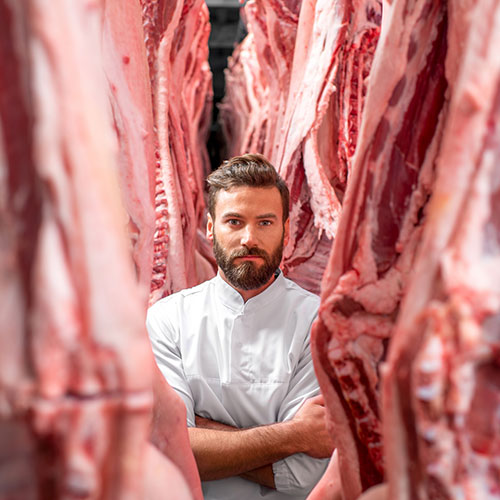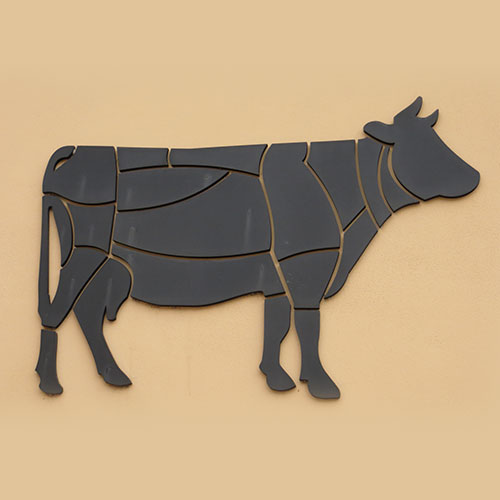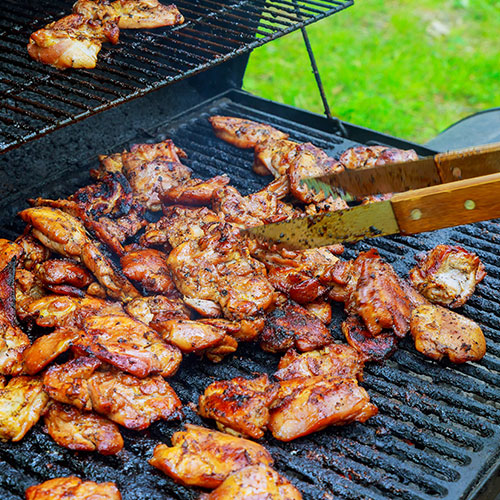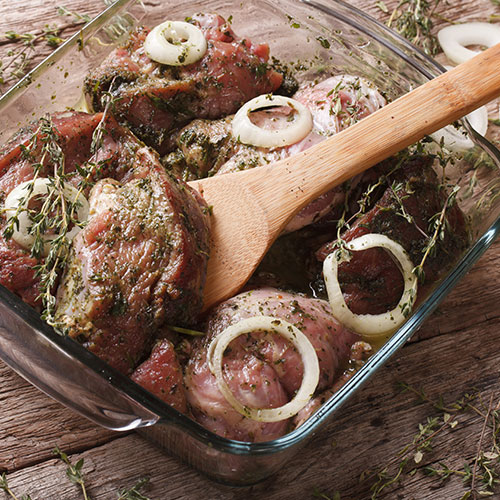FEATURED FOOD - * COVER STORIES *
Being A Butcher
Being A Butcher
How The Profession Has Evolved
Written By Kelly Sennott (ksennott@hippopress.com)
Images: Stock Photo
New Hampshire butcher shops with meat hanging from the ceiling are history, said Billy Steeves, manager at the Prime Butcher in Hampstead. Instead, butchers today are kind of like curators, presenting quality beef, chicken and pork in the best way.
Becoming a Butcher
Historically butchery was something you’d learn via an apprenticeship, but today people enter the vocation through many different doors.
Some jump in because it’s a family business; the Prime Butcher, for example, is a fourth-generation enterprise, owned by Steve George Jr. (His father, Steve George Sr., owns the Prime Butcher in Windham, and his uncle, Christopher George, owns Mr. Steer Meats in Londonderry.) Steeves has a culinary background, having studied at Johnson & Wales University and worked at a restaurant before starting in Hampstead about seven years ago.
Rob Darling, co-owner of Concord Beef and Seafood, said his butchery education happened while he was working in the seafood department at Dole & Bailey in Woburn, Mass. There, he befriended the “meat guys” before starting his Concord business with Al Smith and Michael Souffron 13 years ago.
“I was lucky enough to work for a place where they’d let me wander into the cutting room, poke around and ask a ton of questions,” Darling said.
Goodbye to Rocky
In New Hampshire butcher shops, chances are good you won’t find animal parts hanging from the ceilings anymore — it’s not like Rocky, said Steeves.

Butchers are no longer taking meat straight from the animal and preparing it for customers. Since the ’70s and ’80s, most local shops work from boxed meat ordered from western or midwestern processing facilities, vacuum-sealed shut until ready to be cut and sold.
“This way, not a scrap of the animal is wasted. The big meat companies, they get to make money off every little part they’re processing. With the individual butcher, we get just the parts we want. We’re not paying for the whole weight,” Darling said. (Plus, they don’t have to fill their cooler with a whole cow.)
People who do butchery work — slaughtering and processing meat — do exist in New Hampshire (for example, there’s Lemay & Sons in Goffstown) but they’re few and far between.
“It’s not really butchery anymore — what the actual job is is what they call meat cutting. If I were to hire somebody coming in off the street, they wouldn’t apply for a butcher’s job. They would apply for a meat cutter’s job,” Steeves said.
Day-to-Day
“The art in what I do now is managing the business, which is the most challenging thing, because in the last five years beef prices have gone crazy, whether it’s because of the drought or the demand for beef rising overseas. It’s an expensive product,” Darling said.
Attention to detail is important in today’s butcheries. Customers expect meat to be pristine, and so Steeves said many man-hours go into trimming, tenderizing and marinating (via a vacuum tumbler, which marinates meats fast). There’s lots of back-and-forth between vendors, with the goal of selling only the best, free of hormones.
“Generally, grocery stores cater to the masses. We cater to people who are looking for something a little better, higher-quality. We deal exclusively with upper choice and prime grade meat,” Steeves said.
But the stuff is expensive, and so running a butcher shop also means strategizing how much to buy and when to put it out.
“Once you break the seal, time is ticking. The beef is going to start to brown; you want to sell that within a day. We have super-tight controls over how many steaks are on the tray and when they’re open,” Darling said.
Steeves said the Prime Butcher also offers cooking tips to customers.
“Christmas is huge because a lot of people do prime rib — but they’ve never cooked prime rib. Or turkey. So I actually spend a lot of my days Christmas week with a Sharpie writing those directions right on the packaging,” he said.
Community Shops
Probably most characteristic of these butcher shops is their small-town feel.
“There’s definitely a community aspect to a butcher shop, which you don’t always get in a grocery store,” Darling said. “If you know the guy behind the counter, you know you’re
not getting five-day-old beef. When you’re buying food, you want to be confident in the food you’re buying, especially if it’s something expensive like beef or fish. … And as a butcher shop, we need the support of the community. We can’t have people come in just once in a while.”
Steeves said he knows many customers by their name or regular order.
“You have to really like dealing with customers. A lot of our customers we see five times a week. … This is a small town. Everybody who’s driving, coming home from work, will stop in and say, ‘What looks good tonight?’” Steeves said. “It’s the same people, night in, night out, week in, week out. It’s cool. They get to know you, and you get to know them.”
Beefed Up
Beefed Up
Cuts from the Cow & How to Prepare Them
Written By Matt Ingersol (listings@hippopress.com)
Images: Courtesy/Stock Photo
From hamburgers to London broil steak, filet mignon to jerky, the meat from a cow provides dozens of variations of flavor and tenderness. Local butchers say these differences have mostly to do with the animal’s muscle usage in its body.
“The muscles that the cow uses the most [to move around] often produce the tougher cuts, so those in turn require a longer and slower process of cooking,” said Craig Muccini, owner and general manager at The Flying Butcher in Amherst. “So you want to braise cuts from the leg and shoulder muscles, because they are worked hard, whereas something like a beef brisket you would want to put on a smoker.”

Kyle Perreault, a butcher at Mr. Steer Meats & More in Londonderry, said shoulder clods of beef are great for hamburgers because the meat is usually very lean.
Burger patties are prepared at Mr. Steer using a Hollymatic Super Patty machine. Owner Christopher George said patties are available either as singles through the front case or frozen in 4-ounce or 6-ounce boxes.
“You don’t want to have the meat too lean, because the leaner you make it, the drier it is,” George said. “Between 85 and 90 percent lean is usually a good mark.”
The chuck, a rectangular piece coming from parts of the cow’s shoulder and neck bones, is a cut Perreault recommends slow cooking for a period of time in a crockpot or a pot, due to its fat content.
“Once you get farther down the chuck [on the animal’s body], you get to the short ribs and loins, which are awesome for braising,” Perreault said. “The short loin is also where you get your Porterhouse and T-Bone steaks, and the filet mignon actually comes off of the short loin as well. … The reason a filet is so tender and has very little fat is because there is really no movement; it’s all on the inside.”
Muccini said chuck and short rib cuts are usually not the best to grill because they generally aren’t as tender.
“Tenderness and flavor are a little bit separate from each other,” he said. “You’re not going to be able to [grill] chuck steak cuts for 10 or 12 minutes … and expect to serve it tender as a [short loin] steak.”
Other cuts include the flank and the brisket, which are located in the cow’s chest area.
“The brisket … is a little bit of a fattier piece,” Perreault said. “That’s good for smoking and for slow cooking, and then farther down, where there’s less rib and a little less movement, you have the flank and the skirt, and those are good for grilling.”
Along the hindquarter and back leg areas of the cow, cuts are divided into the top round, bottom round and eye round, located in the center. Below the round is the shank, a tender cut just above the leg bone. Perreault said a lack of fat in these cuts makes for good roasts, and the round cuts are also often used to make beef jerky.
Muccini said some cuts that are not as widely available but can be special ordered include beef cheeks, or the meat from the facial muscles of the cow, and hanger steak, which comes from the animal’s diaphragm area, as well as inner organs like the liver and the kidneys.
“We can’t sell them regularly all the time but we can always order it fresh for the customer,” he said.
As for what you’ll pay, ground beef is going to be cheaper than some of the other bigger steak cuts; depending on how lean it is, it’ll go for around $5.99 or $6.99 per pound.
Briskets are also at about $6.99 per pound. Ribeyes can go for around $15 to $16.99 per pound. Tenderloin steaks like filet mignon and short loin are pricier at about $24.99 per pound.
“Basically the more tender or flavorful it is, the more you are going to pay for it,” he said.
Beyond Beef
Beyond Beef
How & Why To Pick Another Protein
Written By Angie Sykeny (asykeny@hippopress.com)
Images: Stock Photo
If you’re looking for meats other than beef, butcher shops have plenty of options. Here are some options, plus tips from local butchers about how to turn them into a delicious meal.
Chicken
A chicken may be small, but it offers a variety when it comes to cuts. Most cuts above the belly, such as chicken breast, tenderloin and wings, are the white meat, while cuts below the belly, such as the drumsticks and thighs, constitute the dark meat.
“There’s a little bit of a different flavoring,” said Moe Duncan, meat department manager at Quality Cash Market in Concord. “Typically, the darker meat is a little more on the dryer side where the breasts typically have more juice to them.”
There are all kinds of ways to cook chicken; baking, broiling, deep frying and grilling are some of the most common ones. Baking is the easiest, Duncan said, because you can “set it and forget it,” whereas a method like deep frying requires more steps and preparation because of the oil and batter involved. Mainly, it’s about personal preference.
“It comes down to how creative someone wants to be and how much time they’re willing to put into cooking,” Duncan said.

The key thing to remember when cooking chicken is to make sure it’s cooked thoroughly. Use a thermometer, Duncan said, and keep it between 160 and 170 degrees. (The FDA website recommends that all chicken should be cooked to 165 degrees). Different cuts may require more time to cook than others, but Duncan said it’s easy to figure out once you’ve done it a couple times.
“You can’t say how long [to cook it] because it really depends on the size and the weight of the meat, and on the type of oven you have,” he said “It’s a learn-by-trial-and-error thing. You’ll learn over time how long it takes to cook a chicken breast versus a chicken leg.”
Lamb
Cuts of lamb meat can include lamb chops, rack, shank and leg and can be cut into smaller pieces and used for kabobs, stews and other dishes. Some cuts are fattier than others and can produce an excessive amount of grease if not cut properly.
“A good piece will keep just a thin layer of fat on the edge so you don’t burn the meat, but it will have a dryer feel to it,” Duncan said. “Otherwise, if it’s not cut right, you’ll get a very greasy meat, and you’ll only taste the grease and the fat, not the meat itself.”
While lamb meat doesn’t have a lot of flavor on its own, it is a great conductor of added flavors and seasonings, so it’s better to season too little than too much.
“You want to keep it light and simple,” Duncan said. “Stick to things like garlic and rosemary and maybe salt, but a very small amount.”
Pork
Pork includes a variety of cuts from a pig, such as pork chops, loin, roast, tenderloin and ribs. Ham, bacon and sausage also fall into the pork category.
Different cuts carry different flavors and textures.
“It depends where on the line you’re cutting [the meat],” Duncan said. “The pork chops in the center cut — that’s the sweet side. The fat on the edge gives it a sweet flavor, whereas tenderloin is a leaner piece of meat, so it has a more dry taste to it, but it’s still moist enough that it comes apart when you eat it.”
There is also more flavor in a pork cut with the bone in than there is in a boneless cut, Duncan said, because the bone marrow, when cooked, adds flavor and moisture to the meat.
Ribs are most commonly grilled and covered in a sweet or spicy barbecue sauce or seasoning. For pork chops and roasts, however, Duncan recommends baking or pan frying and going light with the seasoning.
“Keep it simple,” he said. “You want a little seasoning and flavor, but you don’t want it to overbear the meat. If you’re going to spend the money on the meat, you want to be able to taste it and enjoy the real flavor of what you’re eating.”
Venison & Buffalo
If you’re looking for a healthier alternative to beef, venison and buffalo are good options. You can do venison or buffalo burgers, steak, tacos, chili — basically anything that you can do with beef, but with a much lower fat content.
“[Buffalo is] very similar to beef,” said Brian Farmer, owner of Yankee Farmer’s Market in Warner, which offers buffalo and venison among its selection of meats. “A lot of people wouldn’t notice the difference, other than the lack of fat. They’d just say, ‘Oh, this is a great steak!’”
Farm-raised venison is also similar to beef, except that cuts of venison meat tend to be a bit smaller. Wild venison, however, doesn’t have the controlled diet that farm-raised venison does, resulting in a stronger gamy flavor.
Since there is little fat in venison and buffalo meat, they’re quick and easy to cook; meat is more dense than fat, Farmer said, so it’s better at holding in heat.
“You have to train yourself not to overcook it and to [stop cooking] when it’s a little too rare, because by the time you get it on the table, it will be just about perfect,” he said.
“Worst-case scenario, you [cook it] for a couple more minutes.”
Soak It Up
Soak it In
How Specialty Marinades Can Make your Protein Pop
Written By Ryan Lessard (news@hippopress.com)
Images: Stock Photo
Specialty marinades can take a so-so dish and turn it into a delicious dinner.
Amy LaBelle, winemaker at LaBelle Winery in Amherst, says marinades serve two purposes: they soften the meat and improve its flavor. “Marinating is a way to elevate especially a tougher cut of meat,” LaBelle said. LaBelle sells a spice blend that, when mixed with olive oil and wine, serves as a marinade. She says wine is an acid between 3 and 4 pH, which helps with the softening process.
There are dry citrus peels in her spice blend, which is also acidic.
“And that is going to soften the fibers in the meat. So you’re all at once flavoring and softening, which is going to create a much better dining experience,” LaBelle said.
She said cooking with wine is very common in French cuisine.
“I lean toward French cuisine. I love French cuisine. I love the flavors in French cooking, but these spice blends that turn into marinade with the addition of wine and olive oil are really, I think, boldly American,” LaBelle said. In addition to making wine, LaBelle loves to cook, so she says creating a spice mix and marinade under “The Winemaker’s Kitchen” label was a natural evolution.
“We’re considering doing the marinade as a pre-done bottle soon, but I like the fact that you can use the spice blend in many different ways,” LaBelle said. She sells three different spice blends designed to work with different proteins. One is for steak, one is used on pork and poultry and the last is for fish.

For the steak marinade mix, she recommends mixing the spices with a red wine. The poultry mix works best with a white wine or the apple wine LaBelle makes with New Hampshire apples. For the fish marinade, she recommends a riesling or a seyval blanc.
“The seyval blanc, in particular, is beautiful as a fish marinade because it itself has a lot of citrus tones,” LaBelle said.
Since she currently sells the spice blend separately, she said it can also be used as a rub or ground in a coffee grinder to create a super-fine “dusting agent.”
“It makes the product more versatile,” LaBelle said.
One of the advantages of using her marinade blend and locally made wine is the lack of additives in both. “For us, you’ve got the confidence of knowing … there’s no chemicals in the bottle,” LaBelle said.
At The Tuckaway Tavern and Butchery in Raymond, general manager Bobby Marcotte said all their Tuckaway brand marinades are gluten-free.
Both LaBelle and Marcotte agree that grocery store marinades are usually either too salty or too sweet.
“It comes down to flavor, right? When you’re customizing and you’re coming up with flavors that you want to produce, you can really dial it in. Whereas I feel a lot of the stuff you buy in the grocery store is going to be one-tone, either sugar or salt,” Marcotte said.
Tuckaway offers a variety of marinades, from teriyaki and Buffalo to its popular house blend. Marcotte said the house blend was actually a recipe carried on from the Yankee Freetown Market, an old butcher shop that used to be in the same building.
“Our house [blend] is obviously our most popular, so we try to keep that really as a stand-alone,” Marcotte said. “It’s really your standard Italian marinade but we kind of elevate the seasonings a little bit — elevate the garlic, elevate the pepper [to] make it really hit you in the mouth when you eat it.”
While Marcotte said the house blend is savory, the second favorite is the opposite. The Fat Boy marinade is made with corn syrup, molasses, ginger and brown sugar.
“Our most popular proteins are definitely our steak tips [and] our No. 2 seller for steak tips would be our Fat Boy marinade, which is sweet and sticky,” Marcotte said.
Local Butcheries
Local Butcheries
Brothers Butcher (8 Spit Brook Road, Nashua, 809-4180, brothers-butcher.com) is a family-owned and -operated butcher shop offering steak and chicken marinades, roasts, pork, sausages, stuffed chicken breasts and other specialty meats that include ground sirloin and beef short ribs. Selections are priced per pound and range from $3.99 to $24.99 depending on the type of meat. It’s open Monday through Friday, 9 a.m. to 7 p.m., and Saturday and Sunday 9 a.m. to 5 p.m.
Campania Market (290 Derry Road, No. 12, Hudson, 880-8300, campaniamarket.net) is a family-owned Italian market with an in-house butcher shop, offering deli meats, homemade sausages and marinated chicken products. The market also offers a line of hand-cut steaks using premium Angus beef. Meats prepared in the butcher shop are used in platters, calzones and pizzas and more available at the market at varying prices. It’s open Tuesday through Saturday, 10 a.m. to 7 p.m., and Sunday 10 a.m. to 5 p.m.
Choice Cuts Butcher Shop & More (707 Milford Road, Merrimack, 718-1262, facebook.com/choicecutsbutchershop) sells locally made grass-fed meat products like marinated steak and chicken, prime rib tenderloin and more. Prices are by the pound and vary depending on the type of meat. It’s open Monday 11 a.m. to 6 p.m., Tuesday 9 a.m. to 6 p.m., Thursday through Saturday 9 a.m. to 7 p.m. and Sunday 9 a.m. to 6 p.m.
Concord Beef & Seafood (79 S. Main St., Concord, 226-3474, concordbeefandseafood.com) is a premium butcher and seafood market offering seafood straight from the Boston Fish Pier, as well as Chairman’s Reserve premium beef and Bell & Evans brand fresh chicken. It’s open Monday through Friday, 10 a.m. to 6:30 p.m., Saturday 10 a.m. to 6 p.m. and Sunday 10 a.m. to 4 p.m.
The Flying Butcher (124 Route 101A, Amherst, 598-6328, theflyingbutcher.com) offers several meat cuts, including prime beef, marinated steak tips, pork, sausage, and seafood, poultry and lamb options. There is also an in-house deli featuring Boar’s Head products, and products provided by local vendors that include fresh produce, toffee, milk, eggs, cheeses and more. Costs of meats range from $5.99 to $24.99 per pound depending on the type of cut. It’s open seven days a week from 9 a.m. to 7 p.m.
The Happy Butchers (222 Elm St., Milford, 554-1339, thehappybutchers.com) has a vast meat selection that includes 1855 Black Angus Beef and Springer Mountain all natural chicken, as well as other meats by the pound like pulled pork, smoked brisket, spare ribs and baby back ribs, pulled chicken and more. Prices range from $7.99 to $24.99 per pound. It’s open Tuesday and Wednesday, 9 a.m. to 6 p.m., Thursday through Saturday, 9 a.m. to 7 p.m., and Sunday, noon to 6 p.m.
The Healthy Buffalo (258 Dover Road, Chichester, 369-3611, healthybuffalo.com) offers specialty meats that include buffalo, ostrich, wild boar, alligator, elk, kangaroo, rabbit and more. Special orders can be made by visiting the store or filling out an order form online. Prices vary depending on the type of meat, the type of cut and the quantity. It’s open Monday through Friday, noon to 6 p.m., and Saturday and Sunday, 10 a.m. to 4:30 p.m. Entrees using their products are also available at The Hungry Buffalo (58 Route 129, Loudon, 798-3737, hungrybuffalotavern.com), which is open Sunday through Wednesday, 11:30 a.m. to 9 p.m., and Thursday through Saturday, 11:30 a.m. to 11 p.m.
Huntspoint Meat Company (114 Calef Highway, Epping, 679-5700, huntspoint.com) offers a variety of barbecue meats, including beef ribs, Gold Wagyu brisket, Berkshire pork, Hatfield pork and more. Prices vary depending on the different options that are available by weight. It’s open Monday, Tuesday and Thursday, 11:30 a.m. to 7 p.m.; Friday and Saturday, 11:30 a.m. to 7:30 p.m., and Sunday, 11:30 a.m. to 6 p.m.
Joe’s Meat Shoppe (229 Atlantic Ave., North Hampton, 964-6152, joesmeatshoppe.com) offers a variety of fresh cut meats like 1855 Black Angus Beef, pork, lamb, veal and poultry, as well as a deli featuring Dietz & Watson products. Prices vary depending on the quantity and type of cut, with beef coming as loin, rib, brisket, flank and chuck, pork as chops, tenderloin and roast, and veal as cutlets. It’s open Monday through Friday, 8 a.m. to 6 p.m., and Saturday, 8 a.m. to 5 p.m.
Lemay & Sons Beef (116 Daniel Plummer Road, Goffstown, 622-0022, lemayandsonsbeef-bbq.com) is a family-owned farmers market style butcher shop specializing in pig roasts using rotisserie style barbecue machines. Other products offered include wholesale and retail beef, pork and poultry. Prices vary depending on the type of meat. It’s open Monday through Friday, 8 a.m. to 6 p.m., and Saturday, 8 a.m. to noon.
Local Provisions (622 Main St., Laconia, 527-8244, localprovisionsnh.com) is a chef-owned butcher shop offering a variety of beef products like rib-eye steaks, sirloin steaks, filets and short ribs, as well as poultry and pork products, dozens of seafood options, veal and lamb chops and shanks, and special order meats that include rabbit, goat, duck, quail, pheasant, elk and more. All products are sourced from farms in New Hampshire and Maine, like Berkshire Farm in Gilford and Meadow View Farm in Gilmanton. It’s open Wednesday through Saturday, 11 a.m. to 6 p.m., and Sunday, 11 a.m. to 4 p.m.
McKinnon’s Market & Super Butcher Shop (236 N. Broadway, Salem, 894-6328; 2454 Lafayette Road, Portsmouth, 559-5714, mckinnonsmarket.com) offers a variety of fresh meats that include Italian sausages, spare ribs, sirloin patties, beef sirloin steak, seafood and more. It also includes an in-house deli and supermarket, with weekly specials on its products available in the store and online. The Salem store is open Monday through Saturday, 8 a.m. to 8 p.m., and Sunday, 8 a.m. to 7 p.m. The Portsmouth store is open Sunday through Wednesday, 8 a.m. to 8 p.m., and Thursday through Saturday, 8 a.m. to 9 p.m.
Mr. Steer Meats & More (27 Buttrick Road, Londonderry, 434-1444, mrsteermeats.com) is a butcher shop and in-house deli that has been in business for four generations dating back to the early 1900s. Products include several different cuts of USDA prime and choice Angus beef, pork tenderloins, baby back ribs, filet mignon, veal cutlets, chops and shanks, and hamburgers to grill yourself. The deli includes Boar’s Head meats, freshly made soups and a serve-it-yourself salad bar. Mr. Steer is open Monday through Friday, 8 a.m. to 6:30 p.m.; Saturday, 8 a.m. to 6 p.m., and Sunday, 8 a.m. to 4 p.m.
The Prime Butcher (201 Route 111, Hampstead, 329-7355; 58 Range Road, Windham, 893-2750, primebutcher.com) offers more than a dozen types of beef cuts like flat cut brisket, filet mignon, Porterhouse steak, fresh ground beef, London broil steak and skirt steak. Other meats available are pork ribs and chops, chicken breasts, cutlets and legs, lamb chops, sausages and more. Specialty cuts include stuffed pork roasts, stuffed pork chops, stuffed chicken breasts, and an Al Capone roast made with prosciutto, pepperoni, provolone cheese and mushrooms stuffed inside of a flank steak. The Hampstead shop is open Monday through Friday, 9:30 a.m. to 6 p.m.; Saturday, 9 a.m. to 5 p.m., and Sunday 10 a.m. to 2 p.m. The Windham shop is open Monday through Friday, 9 a.m. to 6 p.m.; Saturday, 9 a.m. to 5 p.m., and Sunday, 10 a.m. to 2 p.m.
Quality Cash Market (11 Eastman St., Concord, 225-9661, qualitycashmarket.com) has an in-house butcher shop offering marinated steaks, steak tips, chicken and more. It’s open Monday through Friday, 7 a.m. to 7 p.m.; Saturday, 8 a.m. to 7 p.m., and Sunday, 8 a.m. to 6 p.m.
The Tuckaway Tavern & Butchery (58 Route 27, Raymond, 244-2431, thetuckaway.com) offers more than 20 types of handmade sausages and burgers, made fresh daily. There are also marinated chicken tenders, rib-eye and strip steaks, filet mignon, bison tips, pork and more. Other products include homemade chicken salads, desserts, potato salad and pot pies. Prices vary depending on the type and quantity of meat. The butchery is open from 9:30 a.m. to 7 p.m. seven days a week.
Wicked Good Butchah (460 Route 101, Bedford, 488-1832, wickedgoodbutchah.com) offers a variety of meat products, including different cuts of poultry, beef, lamb, pork, sausages and seafood. An in-house deli with Boar’s Head products, prepared foods and fresh baked breads is also available. It’s open Monday through Saturday, 10 a.m. to 7 p.m., and Sunday, 10 a.m. to 6 p.m.
The Wine’ing Butcher (254 Wallace Road, Bedford, 488-5519; 28 Weirs Road, Gilford, 293-4670; 81 Route 25, Meredith, 279-0300; 16 Sheep Davis Road, Pembroke, 856-8855, wineingbutchernh.com) offers USDA prime and choice cut beef, ribs, roasts, chicken wings and breasts and more. A selection of its signature marinades and spice mixes is also available, in addition to a in-house deli offering Boar’s Head products, craft beers and cheeses. The Bedford and Pembroke shops are both open Monday through Saturday, 10 a.m. to 7 p.m., and Sunday, 10 a.m. to 6 p.m. The Gilford shop is open Monday through Saturday, 10 a.m. to 7 p.m., and Sunday, 10 a.m. to 5 p.m. The Meredith shop is open Monday through Saturday, 10 a.m. to 7 p.m., and Sunday, 9 a.m. to 5 p.m.
